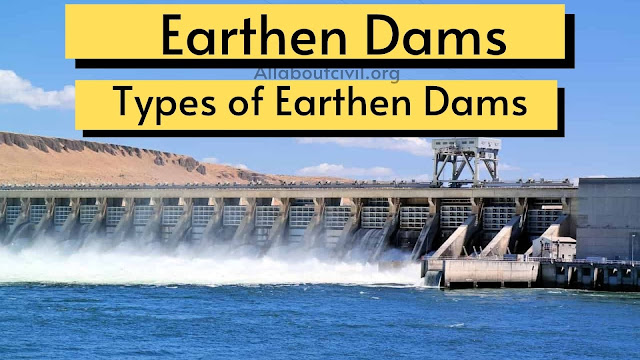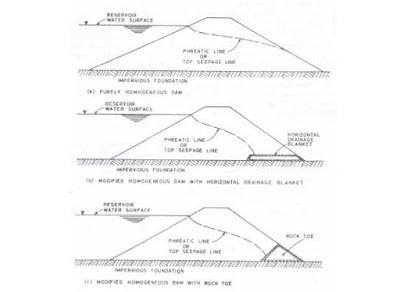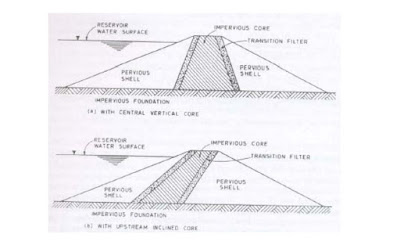
Earth Dams
Earth dams are non-rigid type of dams constructed by using locally available earth or soil.
They are most suitable for the sites where the required foundation at reasonable depth is not available for a masonry / concrete dam. Recently, composite earth and rock-fill type of dams are widely adopted in which quarried rock is used along with soil for construction.
Earth dams are being used since ancient times. But their design and construction was based on empirical methods and the experience gained from similarly constructed dams. The recent advancement in the knowledge of the properties and behavior of soils made it possible to design and construct them with more certainty and confidence.
Examples: Tehri dam across Bhagirathi river – earth and rock-fill type dam (260 m height) Nurek dam across Vakhsh (USSR) – earth dam (304 m height).
Did you know?
whereas,
Banasura sagar dam is the largest earth dam in India and it is also second largest earth dam in the Asia after Hirakud dam which is the largest earth dam in Asia.
Types of Earth Dams based on method of construction
1. Rolled fill earth dam
2. Hydraulic fill earth dam
3. Semi-hydraulic fill earth dam
1. Rolled fill earth dams
These are constructed in successive, mechanically compacted layers. The material is transported from the borrow pits to the dam site, spread to form layers of 15 cm to 45 cm thickness. Each layer is then thoroughly compacted and bonded with the preceding layer by means of rollers.
these are classified into three more types based on section which are explained below with figures.
2. Hydraulic fill earth dams
The soil is transported from the borrow pits to the dam site by mixing with water. The soil is mixed with water (called slush) at the borrow pits itself and transported through flumes / pipes and deposited near the face of the dam.
The coarser material is deposited near the faces and the finer fraction flows towards the center of dam section. This method provides an earth dam of coarser shoulder (outer shell) with impervious core.
3. Semi-hydraulic fill earth dams
These are constructed similar to rolled fill type dams by dumping the material directly procured from the borrow pits. However, some part of the material is moved to the final position by the action of water. Water jets are used to move the fine material from the face of the dam towards the center.
Out of these three types of dams, rolled fill type dams are most commonly adopted. Because in the case of other two types, lack of control in placing the material may result in the failure of dams.
Types of Earth Dams based on section of dam
Rolled fill dams are further classified into:
a. Homogeneous earth dams
b. Zoned earth dams
c. Diaphragm earth dams
a. Homogeneous earth Dams
These types of dams are composed of a single material that is available economically in the nearby sites.
These dams are used for low to moderate heights. The soils used are impervious or semi-impervious soils. With the provision of horizontal drainage blanket or a rock toe or both, homogeneous type dams can be used with steeper side slopes.
Above figure shows the different types of homogeneous earth dams.
b. Zoned earth Dams
These dams consist of a central impervious core of either clay or silt and flanks on either side of pervious material such as sand, gravel, cobbles or mixtures of these. The central impervious core checks the seepage of water while the outer pervious zones support and protect the impervious core. In addition, on the upstream side, the pervious zone provides free drainage during sudden drawdown while on the downstream side it acts as a drain to control the seepage line (top surface of seepage zone).
In general, a dam is considered as zoned type dam if the horizontal width of the impervious core at any elevation is equal to or greater than the height of the dam above that elevation or 3 m whichever is greater.
In between the impervious core and pervious outer zone the transition filters or layers are provided for gradual change in the permeability for the seepage of water. Sometimes, the upstream inclined core may also be provided which help in the construction of downstream portion at earlier stages.
Zoned earth dams with central vertical core and upstream inclined core are shown in the above Fig.
c. Diaphragm Type Dams
These types of dams are used when enough quantity of pervious material is available while the material required for the impervious core is limited.
In such case, the central zone of thin section (width at any elevation less than 3 m or height of dam above that elevation) called diaphragm is provided, which is surrounded by previous material. The diaphragm may be provided with rigid material like impervious soil, cement concrete, bituminous concrete, etc.
The diaphragm may be constructed either at the center or on the upstream face or in between these two positions as you can see in the above fig. However, construction of these types of cores require high degree of precision and control as they have disadvantages of being ruptured due to settlement of dam or its foundation. As such theses dams are used for small heights only.
Also Read : Pre Stressed Concrete-Types of Pre Stressed Concrete Systems



